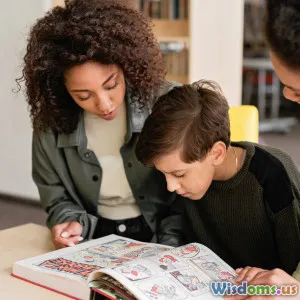
Adapting Education for Diverse Learning Styles
7 min read Explore how to adapt education to various learning styles and achieve effective personalized learning. (0 Reviews)
Adapting Education for Diverse Learning Styles
Education is an ever-evolving sphere, driven by a cultural push toward inclusivity and personalization. Standard methods do not fit every learner; hence, adaptive education emerges as a necessity, accommodating various learning styles. In a classroom where auditory, visual, and kinesthetic learners coexist, how can instructors ensure all students reach their full potential?
The Importance of Diverse Learning Styles
Understanding and appreciating the diversity in learning styles is crucial to enriching education.
What are Learning Styles?
Learning styles are the preferences shown by individuals while acquiring new knowledge—Sternberg’s triarchic theory of intelligence identifies three important areas: analytical, creative, and practical. In addition to these categorizations, there are other modalities:
- Visual learners grasp new information better through charts, graphs, and images.
- Auditory learners thrive in learning environments with discussions or listening components.
- Kinesthetic learners retain knowledge through hands-on experiences.
Real-World Impact of Ignoring Learning Styles
Failure to adapt can result in disengagement and hindered academic performance. A study by the National Center for Learning Disabilities highlights that over 50% of students with learning differences feel disengaged from their current educational environment. Tailoring lessons not only addresses the students' preferences but can significantly bond teachers to their students.
Strategies for Adapting Education
Below are various strategies educators and institutions can undertake to create a learning space that acknowledges and incorporates multiple learning styles:
1. Blend Learning Modalities
Incorporating a mix of teaching styles can better engage students. Blended learning—a combination of traditional classroom instruction, hands-on experiences, and online activities—allows students to interact with the material through different lenses. For instance, a science class related to ecosystems can be taught through visuals like videos, auditory lectures, and group projects where students can build mini-ecosystems.
2. Use Technology to Enhance Engagement
Technology can offer personalization in ways that traditional methods can’t. Tools like Google Classroom allow for differentiated assignments where students can engage based on their strengths. For instance, platforms like Kahoot! engage students with gamified quizzes that audio, visual, and kinesthetic learners can enjoy. Or tools like Nearpod can create interactive lessons where the learning experience is tailored to individual learners.
3. Foster an Active Learning Environment
Active learning engages students in the process rather than passively absorbing information. Peer teaching and group discussions can resonate more with auditory learners, while hands-on group projects suit kinesthetic learners. Group activities that allow students to teach each other play to various learning styles and foster a deeper understanding of the material.
4. Inclusive Assessment Techniques
Assessment is often a bottleneck; standard tests can favor specific learning types over others. By employing varied assessment methods—such as collaborative projects, presentations, and traditional tests—teachers can assess all students meaningfully. One study by OECD's Programme for International Student Assessment (PISA) indicates that a diversification of assessment methods has correlating positive outcomes on students' performances, enhancing opportunities for various learning styles to shine.
5. Personal Learning Plans
Creating individualized learning plans allows educators to tailor educational paths to each student's learning preference. This method knows that students can manifest advanced skills when guided based on their learning modalities. The model encourages proactive teacher-student engagement and motivates students taking ownership of their learning journey. As researcher Carol Ann Tomlinson suggests in her book, “The Differentiated Classroom: Responding to the Needs of All Learners,” differentiation aligns instruction with student needs for improved educational experiences.
Case Studies in Adaptive Education
Example 1: The Montessori Method
The Montessori Method places heavy emphasis on student-led learning tailored to individual progress. For instance, this teaching method promotes cooperative learning style instruction, allowing learners to work at their own pace and learn through play—the core essence of kinesthetic learning leads to better engagement and retention.
Example 2: Technology Integration at Thomas Edison High
Thomas Edison High in New York adopted personalized learning pathways, integrating various technology platforms to address diverse learning styles. Essentially, this means students can seek content delivered via different modalities. For example, through iPad apps, students experience lessons through interactive simulations or videos, revolutionizing retention rates by 20%.
Example 3: Response to Intervention (RTI)
RTI is a multi-tiered approach designed to provide effective educational practices to help children learn. By assessing students to identify their learning needs, interventions are tailored—be it interventions with additional instructional time or specialized programs focused on weaker skills. Schools implementing RTI have improved overall educational effectiveness by over 30%, demonstrating the long-term value of adaptive educational approaches.
Conclusion
In an era of diversified needs in education, adapting educational techniques to diverse learning styles is no longer optional but a necessity. An inclusive approach can transform classrooms into vibrant learning communities where every student thrives. By understanding learning styles, using varied teaching strategies, and integrating technology, educators can offer every student the chance to excel, thereby enhancing overall academic performance and personal growth.
For education to grow into a tailored experience, both educators and institutions must be committed to adapting their techniques to nurture and inspire learners, unleashing their true potential and assuring a brighter future in education.
Rate the Post
User Reviews
Popular Posts





















